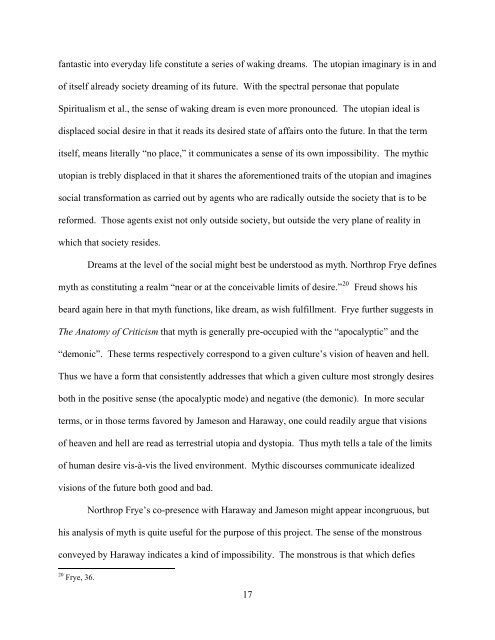A Genealogy of the Extraterrestrial in American Culture
A Genealogy of the Extraterrestrial in American Culture
A Genealogy of the Extraterrestrial in American Culture
Create successful ePaper yourself
Turn your PDF publications into a flip-book with our unique Google optimized e-Paper software.
fantastic <strong>in</strong>to everyday life constitute a series <strong>of</strong> wak<strong>in</strong>g dreams. The utopian imag<strong>in</strong>ary is <strong>in</strong> and<br />
<strong>of</strong> itself already society dream<strong>in</strong>g <strong>of</strong> its future. With <strong>the</strong> spectral personae that populate<br />
Spiritualism et al., <strong>the</strong> sense <strong>of</strong> wak<strong>in</strong>g dream is even more pronounced. The utopian ideal is<br />
displaced social desire <strong>in</strong> that it reads its desired state <strong>of</strong> affairs onto <strong>the</strong> future. In that <strong>the</strong> term<br />
itself, means literally “no place,” it communicates a sense <strong>of</strong> its own impossibility. The mythic<br />
utopian is trebly displaced <strong>in</strong> that it shares <strong>the</strong> aforementioned traits <strong>of</strong> <strong>the</strong> utopian and imag<strong>in</strong>es<br />
social transformation as carried out by agents who are radically outside <strong>the</strong> society that is to be<br />
reformed. Those agents exist not only outside society, but outside <strong>the</strong> very plane <strong>of</strong> reality <strong>in</strong><br />
which that society resides.<br />
Dreams at <strong>the</strong> level <strong>of</strong> <strong>the</strong> social might best be understood as myth. Northrop Frye def<strong>in</strong>es<br />
myth as constitut<strong>in</strong>g a realm “near or at <strong>the</strong> conceivable limits <strong>of</strong> desire.” 20<br />
Freud shows his<br />
beard aga<strong>in</strong> here <strong>in</strong> that myth functions, like dream, as wish fulfillment. Frye fur<strong>the</strong>r suggests <strong>in</strong><br />
The Anatomy <strong>of</strong> Criticism that myth is generally pre-occupied with <strong>the</strong> “apocalyptic” and <strong>the</strong><br />
“demonic”. These terms respectively correspond to a given culture’s vision <strong>of</strong> heaven and hell.<br />
Thus we have a form that consistently addresses that which a given culture most strongly desires<br />
both <strong>in</strong> <strong>the</strong> positive sense (<strong>the</strong> apocalyptic mode) and negative (<strong>the</strong> demonic). In more secular<br />
terms, or <strong>in</strong> those terms favored by Jameson and Haraway, one could readily argue that visions<br />
<strong>of</strong> heaven and hell are read as terrestrial utopia and dystopia. Thus myth tells a tale <strong>of</strong> <strong>the</strong> limits<br />
<strong>of</strong> human desire vis-à-vis <strong>the</strong> lived environment. Mythic discourses communicate idealized<br />
visions <strong>of</strong> <strong>the</strong> future both good and bad.<br />
Northrop Frye’s co-presence with Haraway and Jameson might appear <strong>in</strong>congruous, but<br />
his analysis <strong>of</strong> myth is quite useful for <strong>the</strong> purpose <strong>of</strong> this project. The sense <strong>of</strong> <strong>the</strong> monstrous<br />
conveyed by Haraway <strong>in</strong>dicates a k<strong>in</strong>d <strong>of</strong> impossibility. The monstrous is that which defies<br />
20 Frye, 36.<br />
17















